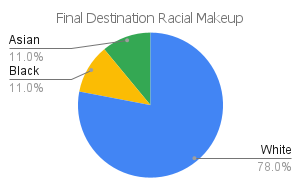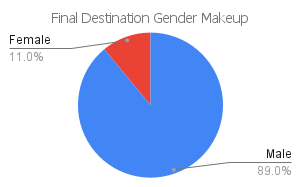Horror Under the Looking Glass: An Comprehensive Analysis of Final Destination
A log crashing straight through the windshield of a police car, a gymnast turned human pretzel, a girl that stood in the street at the wrong time and got hit by a bus, all of these deaths, and even more outrageous ones, are all part of the Final Destination movie series, composed of five movies and a remake. But the most famous of them all is Final Destination (2000), the first film of the entire franchise. This one that sets up the absurd kills and the deeper reflection on the treatment of blue-collar employees that runs through the series, a unique set of films that have found popularity in its originality.
What is the Inclusion Criteria?
The film was selected from RottenTomatoes Top 100 Horror Movies. Once selected, the diversity statistics of the film were analyzed, primarily in terms of the distribution of film leadership roles. The cast/crew roles included in the data analyses include director, writer, lead actors, producers, and executive producers. The data was also formatted into the racial categories of White, Black, Hispanic, Asian, and Middle Eastern, and the gender categories of Male and Female. This was all sorted into two separate pie charts for the movie.
How Inclusive is Final Destination (2000)?
Final Destination (2000) drew a 35% rating from critics and a 68% rating from viewers on Rotten Tomatoes. Within its leadership, 11% of the cast/crew roles of the film were occupied by Asian members, Black members occupied 11%, and White members occupied 78% . In its gender diversity, 11% of the cast/crew comprises female members, with a remaining 89% of male members.


The film starts with the usual trip to the airport, with a group of 7 friends planning on boarding the flight to Paris. But when protagonist Alex Browning gets the suspicion that the plane will explode, he takes action and gets the group of 7 off the plane. It explodes, and the friends are followed by the shadow of death from then on, who plans to carry out their destinies in any way possible. And despite all of their best efforts, including the attempt to get death to skip one of them and thus break the chain of events, death still comes out on top.

What Insight Can We Gain From the Film?
Final Destination is a horror film that doesn’t easily follow the usual tropes and storylines. Unlike slasher films and supernatural flicks, there is no clear boogeyman or evil to vanquish; it is death itself that the characters are trying to overcome. But there is more to this plot than the simple fear of death, though the preoccupation of ourselves as vulnerable creatures made of blood, flesh, and bone is enough of a message to carry it through. The movie provides a commentary surrounding the rise of health and safety culture, particularly how the interests of a company are placed above the safety of its workers; similarly, the individual lives of the group of 7 must be surrendered over to death, and his master plan of life. They must look out for themselves and each other to make it out alive. Few films that have focused on labor rights, but there’s always a first in the genre before it catches on.
How Can We Analyze the Data?
This might have to do in part with the cast/crew’s racial makeup: with 22% of roles occupied by Asian and Black crew members, maybe it’s no coincidence that the films underlying message is to look out for the little guy. Perhaps writer/director James Wong intentionally made Final Destination a little out-of-the-box, so the message surrounding minorities, in general, wasn’t rejected outright but silently told through the outrageous deaths of the characters (because when does a girl suddenly getting hit by a bus not capture the attention of an audience)?
What Can We Conclude?
All-in-all, Final Destination (2000) may not seem like a must-watch horror film at first. But with all of its horrific-to-the-point-of-being-hilarious kills and deeper thematic content, there is at least something to be gleaned from about an hour and a half of its runtime. Or from its five sequels and one remake, if you want more.



